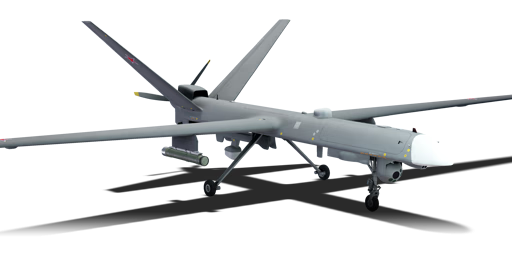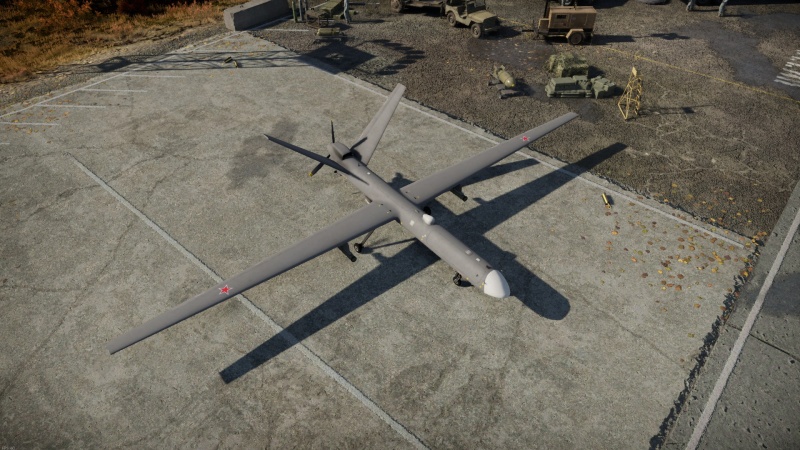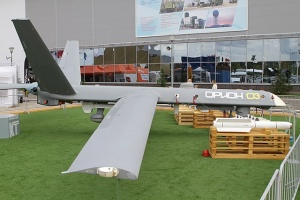Difference between revisions of "Orion"
(Added information for KAB-50 series bombs, more information to weaponry, corrected naming (9M113 > 9M133), situations) (Tag: Visual edit) |
m (HE > SAPHE warhead and minor wording change) (Tag: Visual edit) |
||
| Line 8: | Line 8: | ||
The Orion is a family of Russian unmanned aerial vehicles developed by Kronstadt Group. Its first flight occurred in 2016 after a development process between 2011 and 2015. The drone was meant to be used in reconnaissance and strike missions, with an endurance of 24h and a maximum payload of 250 kg for medium altitude flights. The Strike variant operates small guided bombs or Vikhr-1V laser-guided antitank missiles and has been seen in Syria in 2019 as part of its first deployment in combat. The exact number of Orions in service is unknown, but the number of units built in total is estimated at around 48 drones. | The Orion is a family of Russian unmanned aerial vehicles developed by Kronstadt Group. Its first flight occurred in 2016 after a development process between 2011 and 2015. The drone was meant to be used in reconnaissance and strike missions, with an endurance of 24h and a maximum payload of 250 kg for medium altitude flights. The Strike variant operates small guided bombs or Vikhr-1V laser-guided antitank missiles and has been seen in Syria in 2019 as part of its first deployment in combat. The exact number of Orions in service is unknown, but the number of units built in total is estimated at around 48 drones. | ||
| − | Introduced in [[Update "Drone Age"]], the Orion is a very good choice for players in ground RB that have not researched any CAS and helicopter branches of the tech tree. The Orion can be fitted with two 9M133M-2 or 9M133FM3 missiles, but can also use two laser-guided KAB-50L bombs or two TV-guided KAB-50TV bombs. Both missiles are supersonic, have good manoeuvrability and can be used to destroy most MBTs. The first has a tandem warhead, which means that it has a high penetration but not so much post-penetration damage and requires aiming to parts of the tank with a higher ammo concentration or more crew members, like the turret. The second one uses a high | + | Introduced in [[Update "Drone Age"]], the Orion is a very good choice for players in ground RB that have not researched any CAS and helicopter branches of the tech tree. The Orion can be fitted with two 9M133M-2 or 9M133FM3 missiles, but can also use two laser-guided KAB-50L bombs or two TV-guided KAB-50TV bombs. Both missiles are supersonic, have good manoeuvrability and can be used to destroy most MBTs. The first has a tandem warhead, which means that it has a high penetration but not so much post-penetration damage and requires aiming to parts of the tank with a higher ammo concentration or more crew members, like the turret. The second one uses a semi-armor-piercing high explosive warhead, and even though it may not be enough to destroy all tanks, with overpressure it will kill most MBTs with a well-placed shot in the roof of the vehicle, not to mention that most light targets, like IFVs and SPAAs, are extremely vulnerable to these kinds of warheads. The KAB-50 bombs can provide more forgiving results compared to the missiles on close misses with 24 kg of TnT equivalent, enough to kill some MBTs a meter away, but suffer from slow speeds compared to the missiles, and the KAB-50L laser guided bombs suffer from the Orion's targeting camera having a deadzone underneath it, which can break the lock and laser, causing the bomb to miss. This can be semi-counteracted by moving the drone away from the target. |
== General info == | == General info == | ||
Revision as of 04:38, 29 June 2024
Contents
Description
The Orion is a family of Russian unmanned aerial vehicles developed by Kronstadt Group. Its first flight occurred in 2016 after a development process between 2011 and 2015. The drone was meant to be used in reconnaissance and strike missions, with an endurance of 24h and a maximum payload of 250 kg for medium altitude flights. The Strike variant operates small guided bombs or Vikhr-1V laser-guided antitank missiles and has been seen in Syria in 2019 as part of its first deployment in combat. The exact number of Orions in service is unknown, but the number of units built in total is estimated at around 48 drones.
Introduced in Update "Drone Age", the Orion is a very good choice for players in ground RB that have not researched any CAS and helicopter branches of the tech tree. The Orion can be fitted with two 9M133M-2 or 9M133FM3 missiles, but can also use two laser-guided KAB-50L bombs or two TV-guided KAB-50TV bombs. Both missiles are supersonic, have good manoeuvrability and can be used to destroy most MBTs. The first has a tandem warhead, which means that it has a high penetration but not so much post-penetration damage and requires aiming to parts of the tank with a higher ammo concentration or more crew members, like the turret. The second one uses a semi-armor-piercing high explosive warhead, and even though it may not be enough to destroy all tanks, with overpressure it will kill most MBTs with a well-placed shot in the roof of the vehicle, not to mention that most light targets, like IFVs and SPAAs, are extremely vulnerable to these kinds of warheads. The KAB-50 bombs can provide more forgiving results compared to the missiles on close misses with 24 kg of TnT equivalent, enough to kill some MBTs a meter away, but suffer from slow speeds compared to the missiles, and the KAB-50L laser guided bombs suffer from the Orion's targeting camera having a deadzone underneath it, which can break the lock and laser, causing the bomb to miss. This can be semi-counteracted by moving the drone away from the target.
General info
Flight performance
The Orion has a low top speed. As a propeller-driven UCAV, its climb rate and manoeuvrability are also sub-par. Despite this, it still can carry a devastating loadout of 9M133M-2 or 9M133FM3 missiles.
| Max speed (km/h at 1,000 m) |
Max altitude (metres) |
Turn time (seconds) |
Rate of climb (metres/second) |
Take-off run (metres) | |||
|---|---|---|---|---|---|---|---|
| AB | RB | AB | RB | AB | RB | ||
| 220 | 220 | 7500 | 22.0 | 22.0 | 2.5 | 2.5 | 250 |
Details
| Features | ||||
|---|---|---|---|---|
| Combat flaps | Take-off flaps | Landing flaps | Air brakes | Arrestor gear |
| X | X | X | X | X |
| Limits | ||||||
|---|---|---|---|---|---|---|
| Wings (km/h) | Gear (km/h) | Flaps (km/h) | Max Static G | |||
| Combat | Take-off | Landing | + | - | ||
| 390 | 450 | N/A | N/A | N/A | ~__ | ~__ |
| Optimal velocities (km/h) | |||
|---|---|---|---|
| Ailerons | Rudder | Elevators | Radiator |
| < 250 | < 250 | < 250 | >250 |
Survivability and armour
Aircraft survivability is quite an issue with most drone types, with drones being not only incredibly slow manoeuvring wise but also top speed wise.The structural integrity is also sub par with simple 7.7 mm MG's being able to take it out. One major benefit of drones is that you don't have a pilot to die as it is unmanned which means that you cant "black out: from G's either. There is no armour and the wings are quite fragile.
Armaments
Suspended armament
The Orion can be outfitted with the following ordnance:
- 2 x 9M133M-2 missiles
- 2 x 9M133FM3 missiles
- 2 x 50 kg KAB-50L bombs (100 kg total)
- 2 x 50 kg KAB-50TV bombs (100 kg total)
The 9M133M-2 Kornet-М is a supersonic tandem warhead (HEAT) missile, good for destroying MBTs that players at this battle rating will commonly face. It has a good flight speed and decent maneuverability, so you can for the most part reach any target so long as it is within the missile's strike range. It is quite capable of overpressure with the 6.36 kg TnT equivalent blast force.
The 9M133FM3 Kornet-М is a supersonic missile with a SAP-HE warhead, penetrating as much as 61 mm of armour from with 9.24 kg of TnT equivalent. The blast is easily enough to knock out most MBTs when hitting places that can trigger overpressure, such as the turret, roof and hull roof. However, the 9M133M-2 is still very capable of overpressure and can atleast penetrate armor with its HEAT warhead, while the SAP-HE warhead's low penetration will merely scratch the target on a non-overpressure hit.
The laser guided KAB-50L is a precise bomb that can deal more damage in a wider area compared to the Kornet missiles with around 2.3x the explosive mass of the 9M133FM3. However, it suffers greatly from the Orion's sluggish speed, forcing the operator to fly almost directly above the target in order to drop the bombs accurately with the CCIP. This causes another issue, however; the targeting camera's limits (same with all other strike UAVs) create a large deadzone underneath the Orion where the camera is unable to focus on. Because the KAB-50L relies on laser guidance, this lock can be broken if the camera enters the deadzone. However, this can be avoided by moving the UAV away from the target, such as moving left or right, where the camera will still be able to maintain lock.
The TV guided KAB-50TV is alike to the KAB-50L, however the issues caused by the camera's deadzone are not a problem as it uses TV guidance instead of constant LoS to the target (Laser guidance), also allowing both bombs to be dropped because of its fire-and-forget nature. The only downside of the KAB-50TV relative to the KAB-50L is its less precise nature and inability to correct the course (Locking onto the wrong object, such as a destroyed tank).
Usage in battles
The Orion fills a good niche as the "everyman's CAS". It is available to everyone, which can be very beneficial to players who have not researched BR appropriate aircraft or helicopters. You start off by spawning at an altitude of 4000 meters above the battlefield. Your main priority is SPAA - they are usually found stationary at the enemy spawn. Destroying them will not only help your survival, but also enable your fellow helicopter/aircraft pilots to move in and provide better, uninterrupted CAS. If there are no SPAA around, your next target would be enemy tanks that are near/on the capture points. Once you fire both pieces of armament, you have three options:
- Loiter over the battlefield and provide reconnaissance: Just because you can no longer use your missiles doesn't mean you can't help your team! Fly around the battlefield and scan the area with your amazing optical camera. Once you spot any enemy vehicles that pose a threat to your team, quickly mark them on the map and tell your teammates using the in-game chat (alternatively if you have any squad mates, you can work with them and point out enemies nearby using the squad marker)
- Land and rearm: Once the two weapons are used, reduce your throttle and glide towards the airbase. Once you land, begin any repairs and necessary rearming so you can take off. It should be worth noting that the Orion UCAV suffers from a low speed and a horrid climb rate, making the return to base and return to the battlefield incredibly lengthy. Altitude is also the only saving grace of the Orion, as helicopters/attack aircraft will generally be at lower altitudes and SPAAs will have no trouble sending a very slow target back to the hangar screen. Consequently, fighting at low altitudes should be regarded as a suicide mission.
- Bail out of the vehicle and spawn in a more capable vehicle: While it feels counterintuitive to bail out of a vehicle that cost 750 spawn points, it is the fastest way to get you back into the battle. Using the spawn points you accumulated, you can get enough to spawn another tank, an attack aircraft, or a helicopter. The advantage of this is that you should have cleared the path for you or other pilots to make some damage, as the SPAAs and anti-air threats are no longer there.
Pros and cons
Pros:
- Spawns at altitude (4000 meters), giving better vision over the map and ability to target ground vehicles' roofs
- Access to two devastating 9M133M-2 or 9M133FM3 missiles or alternatively KAB-50L (50 kg) or KAB-50TV (50 kg) precision guided bombs
- Exceptional optical camera with 2nd gen thermals
- Hard to counter by SPAA
- Available for everyone to use
Cons:
- Low maximum speed
- Terrible climb rate
- Access to only two weapons for a price higher than most helicopters and attack aircraft (which can carry more weaponry)
- A large amount of time will be spent going from spawn to the airfield to rearm and back - better off bailing out and spawning another vehicle
- Smallest launch window of the strike UAVs, making it often needed to dip down in order to fire, losing altitude and becoming more revealing to SPAA
History
The Orion UCAV (also known as Kronshtadt Orion) is a family of unmanned vehicles developed by the Russian company Kronstadt Group. The development of the Orion platform can be traced to 2011 as part of the Russian MoD-funded Inokhodets program. The company later revealed the first layout of the Orion with its first flight being reported to happen in 2016. The Orion was idealized from the start to be a multipurpose weapon, capable of reconnaissance and strike missions.
The armed variant, was developed to be able to carry a payload weight of 250 kg with a maximum payload of 4 missiles or bombs. It was meant to be fitted with the Vikhr-1V laser-guided anti-tank missile and when it's used for combat operations that is its primary loadout.
The Orion has other variants and has also been through different upgrade programs. The Orion (Inokhodets) is the base version of the Orion family and the one currently in use by the Russian Armed Forces, this version also was adapted to export, through the Orion-E variant. The Orion-E is an export variant of the reconnaissance version of the Orion, that has not found any client yet. The Orion-2 (Helios) is a larger version of the Orion, meant to be used for longer flights in high altitudes, instead of the medium altitude flights of the base Orion. This version is meant to have a flight time of around 30h, with a weight of 5 tons and is still in development, with the first flight originally intended to be in 2023. Finally the Inokhodets-RU (Sirius) was an upgraded version of the Orion with a bigger and different design. With two engines instead of one, it increased the total payload to 450 kg and the cruise speed to 295 km/h, with a flight time of 40h. While not currently in mass production, it was successfully tested in 2022 in joint operations with piloted aircraft and its first flight occurred in 2023.
Media
Excellent additions to the article would be video guides, screenshots from the game, and photos.
See also
External links
| Kronstadt Group | |
|---|---|
| Drones | Orion |
| Strike UCAVs | |
|---|---|
| USA | MQ-1 |
| USSR | Orion |
| China | Wing Loong I |






